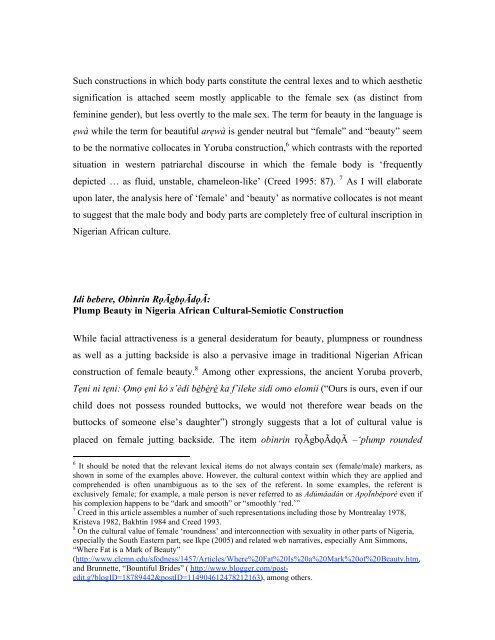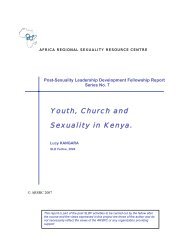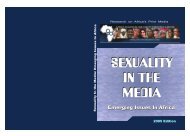body images beauty culture and language - Africa Regional ...
body images beauty culture and language - Africa Regional ...
body images beauty culture and language - Africa Regional ...
You also want an ePaper? Increase the reach of your titles
YUMPU automatically turns print PDFs into web optimized ePapers that Google loves.
Such constructions in which <strong>body</strong> parts constitute the central lexes <strong>and</strong> to which aesthetic<br />
signification is attached seem mostly applicable to the female sex (as distinct from<br />
feminine gender), but less overtly to the male sex. The term for <strong>beauty</strong> in the <strong>language</strong> is<br />
ẹwà while the term for beautiful arẹwà is gender neutral but “female” <strong>and</strong> “<strong>beauty</strong>” seem<br />
to be the normative collocates in Yoruba construction, 6 which contrasts with the reported<br />
situation in western patriarchal discourse in which the female <strong>body</strong> is ‘frequently<br />
depicted … as fluid, unstable, chameleon-like’ (Creed 1995: 87). 7 As I will elaborate<br />
upon later, the analysis here of ‘female’ <strong>and</strong> ‘<strong>beauty</strong>’ as normative collocates is not meant<br />
to suggest that the male <strong>body</strong> <strong>and</strong> <strong>body</strong> parts are completely free of cultural inscription in<br />
Nigerian <strong>Africa</strong>n <strong>culture</strong>.<br />
Idi bebere, Obìnrin RọÃgbọÃdọÃ:<br />
Plump Beauty in Nigeria <strong>Africa</strong>n Cultural-Semiotic Construction<br />
While facial attractiveness is a general desideratum for <strong>beauty</strong>, plumpness or roundness<br />
as well as a jutting backside is also a pervasive image in traditional Nigerian <strong>Africa</strong>n<br />
construction of female <strong>beauty</strong>. 8 Among other expressions, the ancient Yoruba proverb,<br />
Tẹni ni tẹni: Ọmọ ẹni kò s’èdí bèbèrè ka f’ileke sidi omo elomii (“Ours is ours, even if our<br />
child does not possess rounded buttocks, we would not therefore wear beads on the<br />
buttocks of someone else’s daughter”) strongly suggests that a lot of cultural value is<br />
placed on female jutting backside. The item obìnrin rọÃgbọÃdọÃ –‘plump rounded<br />
6<br />
It should be noted that the relevant lexical items do not always contain sex (female/male) markers, as<br />
shown in some of the examples above. However, the cultural context within which they are applied <strong>and</strong><br />
comprehended is often unambiguous as to the sex of the referent. In some examples, the referent is<br />
exclusively female; for example, a male person is never referred to as Adúmáadán or ApọÏnbéporé even if<br />
his complexion happens to be “dark <strong>and</strong> smooth” or “smoothly ‘red.’”<br />
7<br />
Creed in this article assembles a number of such representations including those by Montrealay 1978,<br />
Kristeva 1982, Bakhtin 1984 <strong>and</strong> Creed 1993.<br />
8<br />
On the cultural value of female ‘roundness’ <strong>and</strong> interconnection with sexuality in other parts of Nigeria,<br />
especially the South Eastern part, see Ikpe (2005) <strong>and</strong> related web narratives, especially Ann Simmons,<br />
“Where Fat is a Mark of Beauty”<br />
(http://www.clcmn.edu/sfodness/1457/Articles/Where%20Fat%20Is%20a%20Mark%20of%20Beauty.htm,<br />
<strong>and</strong> Brunnette, “Bountiful Brides” ( http://www.blogger.com/postedit.g?blogID=18789442&postID=114904612478212163),<br />
among others.






